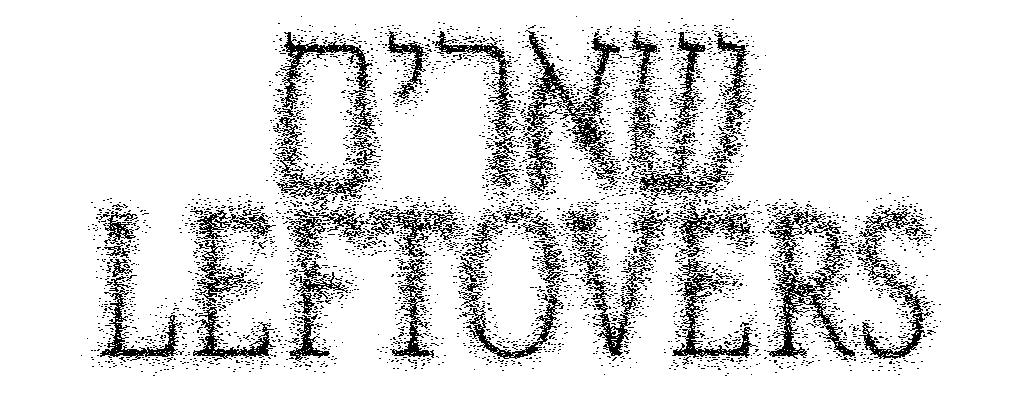
שׁוּחוֹת אַחֲרוֹנוֹת
שׁוּחוֹת אַחֲרוֹנוֹת (מתוך שְׁאֵרִים), 2024
קולאז' דיגיטלי, 275 ס"מ על 220 ס"מ
Schützengräben
Schützengräben (from Leftovers), 2024
Digital Collage, 275 cm x 220 cm

And the earth was without form, and void; and darkness was upon the face of the deep, and the spirit of God did not move upon any place.
At first glance, "Schützengräben" transports the viewer straight into the trench warfare of World War I in Europe. The photographic style associated with the period—sharp black-and-white contrasts, meticulously staged angles, and dense, detail-rich compositions—lends the work an appearance of historical documentation, as if it had been pulled from an old military archive. Yet, as the eye lingers, a sense of disorientation begins to take hold.
Visual elements from different eras—tanks and vehicles from World War II, structures that seem to belong to the Cold War era, and trenches that do not fully align with the known imagery of European battlefields—undermine the scene's apparent historical authenticity. The image reveals itself not as a fixed historical record but as a visual montage of overlapping timelines, a place where all modern wars converge into one unending narrative.
The choice to adopt the photographic aesthetic of World War I only amplifies the dissonance: what initially seems to be historical evidence transforms into a timeless space where reality unravels. The large-scale collage disrupts chronological logic and creates a landscape that refuses to remain confined to a single historical moment.
The initial shock comes from the overwhelming density of imagery and the extreme graphic nature of the work: half-empty trenches, scattered remains of soldiers and equipment, and remnants embedded in earth saturated with mud and blood. The collage demands that the viewer delve deeper to uncover the multilayered absence of a coherent narrative. Much like in the works of Hieronymus Bosch, the viewer experiences a kind of awakening—from historical documentation to a symbolic image, where the landscape is not the site of a single war but a reflection of all human conflicts. Similarly, as in Francisco Goya's "The Disasters of War", the piece confronts the viewer with the raw horror of human suffering. While Goya captured the direct atrocities of his time, here, the imagery of destruction becomes a universal and allegorical metaphor. The influence of avant-garde artists like Otto Dix and Paul Nash is also evident, reflecting their explorations of landscapes and humanity in the aftermath of the Great War.
"Schützengräben" is an investigation into the gap between what appears to be historical imagery and what unfolds as an imagined and layered landscape. The work illustrates how wars, even when they end, leave behind reverberating echoes. Among the fragments of structures and the remnants of life, a profound sense emerges of standing before an endless catastrophe—a ruin that seems perpetually incomplete. Rather than offering a clear resolution, the work invites the viewer to linger within a labyrinth where nothing is whole, much like the trenches themselves—open, exposed, and never truly ending.

וְהָאָרֶץ הָיְתָה תֹּהוּ וָבֹהוּ, וְחֹשֶׁךְ עַל פְּנֵי תְּהוֹם, וְרוּחַ אֱלֹהִים לֹא רִחֲפָה בְּשׁוּם מָקוֹם:
במבט ראשון, "שוּחוֹת אַחֲרוֹנוֹת" מטילה את הצופה הישר אל תוך מלחמת החפירות באירופה של מלחמת העולם הראשונה. הסגנון הצילומי המזוהה עם התקופה – ניגודי השחור-לבן החדים, זוויות מבוימות בקפידה ודימוי דחוס ורווי פרטים – מקנה לעבודה מראה של תיעוד היסטורי, כאילו נשלף מארכיון צבאי ישן. אך ככל שהעין מתעכבת, תחושת הבלבול מתחילה לחלחל.
אלמנטים חזותיים מתקופות שונות – טנקים וכלי רכב ממלחמת העולם השנייה, מבנים הנראים כשייכים לעידן המלחמה הקרה ותעלות לחימה שאינן תואמות לחלוטין את המוכר מהחפירות באירופה – מערערים את הבסיס ההיסטורי לכאורה של הסצנה. הדימוי מתגלה לא כהיסטוריה חקוקה אלא כתצריף חזותי של זמנים שונים, מקום שבו כל מלחמות העידן המודרני מתלכדות לכדי סיפור אחד מתמשך.
הבחירה לאמץ את הסגנון הצילומי של מלחמת העולם הראשונה רק מעצימה את הדיסוננס: מה שנראה תחילה כעדות היסטורית הופך למרחב אל-זמני שבו המציאות מתערערת. הקולאז' גדול הממדים משבש את ההיגיון הכרונולוגי ויוצר נוף שמסרב להישאר נעול בתוך פרק זמן אחד.
ההלם הראשוני נובע מעומס הדימויים ומהגרפיות הקיצונית של העבודה: השוחות הריקות למחצה, שרידי גופות החיילים והציוד הפזורים על הקרקע, ושְׁאֵרִים הטבועים באדמה רוויה בבוץ ובדם. הקולאז' דורש מהצופה להעמיק מבט ולגלות את הרב-שכבתיות של נרטיב שאינו קיים. כמו אצל הירונימוס בוש, הצופה עובר חוויה של התפכחות – מתיעוד היסטורי לדימוי סימבולי, שבו הנוף אינו זירה של מלחמה אחת אלא מראה של כל מלחמות האנושות. ובדומה לאפקט שיצר פרנסיסקו גויה בסדרת "זוועות המלחמה", העבודה מעמתת את הצופה עם האימה האנושית החשופה ביותר. בעוד גויה תיעד את זוועות תקופתו, כאן דימויי ההרס הופכים למטאפורה כללית ואוניברסלית. ניכרת גם ההשפעה של אמני האוונגרד כמו אוטו דיקס ופול נאש, שהתייחסו לנוף ולאנושות שנותרה אחרי המלחמה הגדולה.
"שוּחוֹת אַחֲרוֹנוֹת" היא חקירה של הפער בין מה שנראה כדימוי היסטורי לבין מה שמתגלה כנוף מדומיין ומרובד. העבודה ממחישה כיצד מלחמות, גם כשהן מסתיימות, מותירות אחריהן גלים של הדהוד. בין שברי המבנים ושארי החיים עולה תחושה של עמידה מול קטסטרופה אינסופית – חורבן שנראה כי לעולם אינו נגמר. במקום לספק מענה ברור, העבודה מזמינה את הצופה להשתהות בתוך לבירינט שבו שום דבר אינו שלם, כמו החפירות עצמן – פתוחות, חשופות ולעולם לא מסתיימות.









